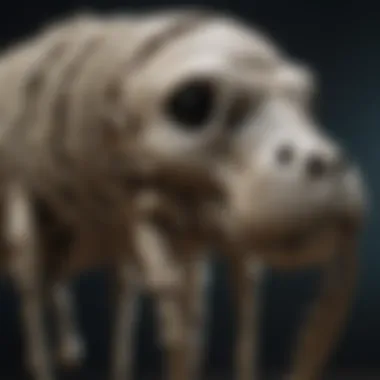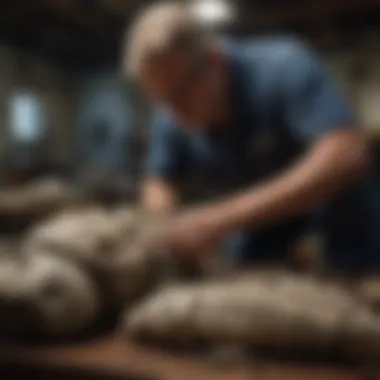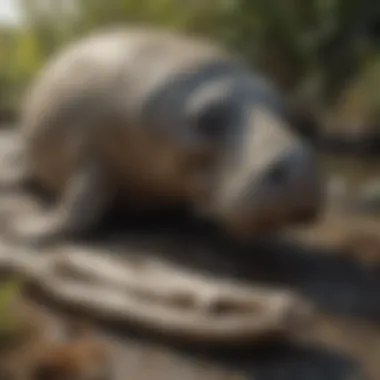Uncover the Enigmatic World of Manatee Bones: An Expert's Guide


Rock and Fossil Identification
The world of manatee bones offers a unique opportunity for enthusiasts to delve into the realm of rock and fossil identification. When exploring manatee bones, it is essential to understand the types of rocks and fossils that may be associated with these majestic creatures. Manatee bones themselves are not fossilized, but they can often be found in geological formations that contain fossil remains of other marine life.
When identifying manatee bones, there are specific characteristics to look for that set them apart from other marine mammal remains. These may include the size and shape of the bones, the texture of the bone surface, and the presence of distinguishing features such as barnacle markings. Tools for identification, such as calipers, magnifying glasses, and reference guides, can aid enthusiasts in accurately identifying and categorizing manatee bones.
Collecting Tips and Techniques
Collecting manatee bones requires a delicate balance of passion and responsibility. Best practices for collecting include obtaining the necessary permits and permissions to ensure compliance with legal regulations regarding the collection of protected species. Manatee bones should only be collected from sites where they have naturally washed ashore or from reputable sources that ethically source the remains.
Locating prime collecting sites for manatee bones can be a challenge, as these marine mammals typically inhabit shallow coastal waters and estuaries. Enthusiasts may need to collaborate with local authorities, marine biologists, and conservation organizations to identify suitable collection locations. When extracting specimens, it is crucial to employ safe and non-invasive techniques to minimize disruption to the natural habitat.
Preservation and Display
Once manatee bones have been collected, enthusiasts must prioritize proper preservation techniques to ensure the longevity and integrity of the specimens. Preservation methods may include cleaning, degreasing, and stabilizing the bones to prevent decay and deterioration. Proper storage methods, such as using acid-free tissue paper and sturdy boxes, help protect the bones from environmental damage and insect infestations.
Creative display ideas can showcase manatee bones in a visually appealing and educational manner. Enthusiasts may consider creating themed exhibits that highlight the anatomy and skeletal structure of manatees, accompanied by informative plaques detailing the significance of these marine mammals in ocean ecosystems.
Geological Insights
Exploring the geological insights offered by manatee bones provides a deeper appreciation for the historical significance of these creatures. Geological formations where manatee bones are discovered offer clues about the past environments and marine ecosystems. Studying the geological context of these remains can reveal insights into the evolution of manatees and their adaptations to changing habitats.
The historical significance of manatee bones extends to notable discoveries in the field of paleontology. Fossils of ancient manatee species have provided scientists with valuable information about the evolutionary history of these aquatic mammals and their connections to other marine species. By examining manatee bones from different geological time periods, researchers can uncover crucial data about climate change, biodiversity, and species evolution.


Introduction to Manatee Bones
In the vast ocean of scientific exploration, the study of manatee bones stands as a beacon of fascination and intrigue. For enthusiasts and collectors alike, understanding the anatomy and significance of these majestic creatures' skeletal remains unveils a world of wonder and insight. This section serves as a gateway into the captivating realm of manatee bones, shedding light on their unique characteristics, rarity, and the ethical considerations that accompany their collection and preservation. From unraveling the intricate skeletal structure to delving into the scientific and cultural value, this introduction sets the stage for a deep dive into the enchanting world of manatee bones.
Understanding Manatees' Anatomy
The Skeletal Structure of Manatees
Exploring the skeletal structure of manatees reveals a marvel of evolution and adaptability. The robust bones of these gentle giants provide structural support and aid in buoyancy, essential for their aquatic lifestyle. One key characteristic of manatee skeletons is their dense and sturdy composition, perfectly suited for navigating the waterways with grace and agility. The unique feature of elongated bones, particularly in their flippers and spine, enhances their swimming ability and distinguishes them as masterful aquatic beings. Understanding the skeletal structure of manatees not only unveils their physical prowess but also showcases the beauty of nature's design in creating such magnificent creatures.
Unique Features of Manatee Bones
Diving deeper into manatee bones reveals a treasure trove of unique features that captivate collectors and scientists alike. One key characteristic is the composition of manatee bones, known for their hardness and durability. This makes manatee bones a popular choice for study and collection due to their long-lasting nature and ability to withstand the test of time. The intricate patterns and textures displayed in manatee bones add to their allure, making them a sought-after item for enthusiasts with a keen eye for detail. While the advantages of owning manatee bones are plentiful, it is crucial to consider the ethical implications of acquiring these precious relics and ensure responsible collection practices are upheld throughout the process.
Significance of Manatee Bones
Scientific Value of Manatee Skeletons
The scientific value inherent in manatee skeletons transcends mere anatomical study, offering a window into the evolutionary history and ecological adaptations of these gentle giants. Each bone holds a story waiting to be deciphered, providing researchers with valuable insights into the biology and behavior of manatees. The key characteristic of manatee skeletons lies in their ability to serve as invaluable educational tools, aiding in the preservation and understanding of these endangered species. By studying manatee bones, scientists can unravel the mysteries of the oceans and contribute to conservation efforts aimed at protecting these magnificent creatures for generations to come.
Cultural and Artistic Perspectives
Beyond their scientific importance, manatee bones hold a unique place in cultural and artistic realms, inspiring awe and creativity among admirers. From ancient legends to modern-day artwork, manatee bones have woven themselves into the tapestry of human expression, symbolizing grace, strength, and the interconnectedness of all living beings. The key characteristic of manatee bones in cultural narratives is their ability to bridge the gap between nature and art, serving as tangible reminders of our shared heritage and responsibility to safeguard the environment. By acknowledging the cultural and artistic perspectives surrounding manatee bones, collectors and enthusiasts can deepen their appreciation for these creatures and advocate for their protection on a global scale.


Legal and Ethical Considerations
In the expansive world of manatee bones, delving into legal and ethical considerations is imperative to comprehend the nuanced realm of collecting and owning these precious skeletal remains. This section serves as a pivotal juncture in highlighting the ethical responsibilities that come with engaging in the acquisition of manatee bones, emphasizing the legal frameworks designed to protect these gentle giants and their habitats. By exploring the legal and ethical facets of manatee bone collection, enthusiasts and collectors gain a profound understanding of their role in preserving these magnificent creatures.
Laws Governing the Sale of Manatee Bones
Protected Status of Manatees
The protected status of manatees stands as a cornerstone in safeguarding these endangered marine mammals from exploitation and harm. Manatees are classified as threatened or endangered species in various regions, invoking stringent laws and regulations to shield them from the perils of commercial trade and human interference. This designation underscores the urgency of conserving manatees and their habitats, reflecting a global commitment to ensuring their survival in a rapidly changing world. The protected status of manatees resonates deeply in this article, imparting a sense of responsibility and reverence towards these enchanting creatures and their delicate ecosystems.
Illegal Trade and Penalties
The shadow of illegal trade looms ominously over the realm of manatee bones, posing a grave threat to the conservation efforts aimed at safeguarding these marine marvels. Illicit trafficking of manatee bones not only decimates populations but also undermines the integrity of conservation laws, leading to severe penalties for offenders. The insidious nature of illegal trade in manatee bones defies ethical norms and legal boundaries, underscoring the critical need for stringent enforcement and public awareness. By shedding light on the perils of illegal trade and associated penalties, this article serves as a clarion call for upholding ethical principles and fostering a culture of respect towards manatees and their skeletal legacy.
Ethical Dilemmas in Collecting Manatee Bones
The ethical dilemmas surrounding the collection of manatee bones pose profound questions regarding the impacts of human actions on fragile ecosystems and species survival. At the crux of these dilemmas lie conflicting priorities between conservation goals and human interests, underscoring the need for a balanced approach towards collecting and preserving manatee remains. By navigating the complex terrain of conservation implications and cultural considerations, collectors and enthusiasts are tasked with making ethically sound decisions that prioritize the long-term well-being of manatees and their habitats.
Conservation Implications
The conservation implications of collecting manatee bones extend far beyond individual possessions, reverberating through ecosystems and conservation initiatives aimed at protecting these gentle giants. Each bone holds a ecological significance, symbolizing the interconnectedness of manatees with their environment and human stewards. Understanding the conservation implications embedded in collecting manatee bones fosters a deeper appreciation for the intricate web of life that sustains these magnificent creatures, urging collectors to tread lightly and mindfully in their pursuits.
Cultural Considerations


Amidst the scientific and legal discourse surrounding manatee bone collection, cultural considerations offer a unique lens through which to view these ancient relics. Cultural perspectives shape attitudes towards manatees and their remains, intertwining heritage, belief systems, and artistic expressions within the tapestry of human interactions with nature. By embracing cultural considerations, collectors embark on a journey of discovery that transcends mere acquisition, delving into the rich tapestry of narratives and traditions that elevate manatees from mere specimens to revered symbols of resilience and harmony.
Manatee Bones for Sale
In this segment of the article, we delve into the crucial aspect of acquiring manatee bones, shedding light on the significance and intricacies surrounding the sale of these unique specimens. As avid enthusiasts and collectors seek to enhance their collections, understanding the availability of manatee bones becomes paramount. By exploring the avenues through which these remarkable skeletal remains can be obtained, individuals gain a deeper appreciation for the rarity and value attached to manatee bones. From scientific researchers to passionate collectors, the accessibility of manatee bones opens up a realm of exploration and discovery.
Availability of Manatee Bones
Sources for Purchasing Manatee Bones
The acquisition of manatee bones is a specialized endeavor, with designated sources playing a pivotal role in offering these coveted items to interested individuals. Whether procured through authorized dealers, auctions, or reputable museums, the availability of manatee bones varies across different platforms. Each source brings a unique perspective to the table, ensuring a diverse range of choices for prospective buyers. The reliability and authenticity of these sources prove indispensable, emphasizing the need for due diligence when selecting where to purchase manatee bones.
Considerations for Buyers
For buyers contemplating the acquisition of manatee bones, several crucial considerations come into play. Factors such as legal compliance, ethical sourcing, and the preservation of these skeletal treasures weigh heavily on the decision-making process. Recognizing the ethical responsibilities tied to owning manatee bones heightens the significance of making informed choices. Buyers must navigate through a landscape rife with legal implications and conservation principles to ensure the sustainability and integrity of their collections. As custodians of these remarkable artifacts, buyers hold a significant position in safeguarding the legacy of manatees and their skeletal remnants.
Conclusion
In this meticulous guide to the fascinating world of manatee bones, it becomes clear that these skeletal remains hold immense significance beyond mere curiosity. The reader is taken on a journey that uncovers the veil of mystery surrounding manatee bones, shedding light on their rarity, historical relevance, and ethical dimensions. By delving into the intricate details of manatee bone collection, this article serves as a beacon for both enthusiasts and collectors, presenting a comprehensive overview of a niche yet compelling subject matter.
Appreciating the Beauty of Manatee Bones
A reflection on the allure of manatee skeletons
Exploring the captivating allure of manatee skeletons unveils a realm of fascination rooted in the ancient allure of these magnificent creatures. The skeletal anatomy of manatees offers a unique perspective on their evolutionary path and biological adaptations. Understanding the intricate structures that support these gentle giants provides a profound appreciation for the complexity of nature's design. Embracing the ethereal beauty encapsulated within manatee skeletons allows collectors to connect with a piece of history that transcends time, inviting contemplation on the wonders of the natural world.
The importance of responsible collection practices
Highlighting the importance of responsible collection practices underscores the ethical considerations inherent in owning manatee bones. Emphasizing sustainable acquisition methods and respecting conservation efforts are paramount in preserving these majestic creatures' legacy. By advocating for ethical practices, collectors not only contribute to conservation efforts but also set a precedent for future generations to uphold the sanctity of nature. Appreciating the value of responsible bone collection extends beyond mere possession, nurturing a sense of environmental stewardship and reverence for the interconnectedness of all living beings.







